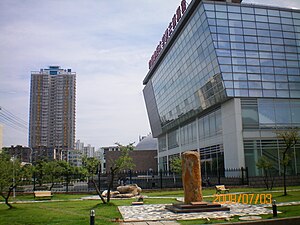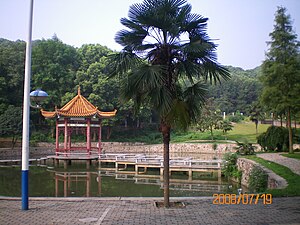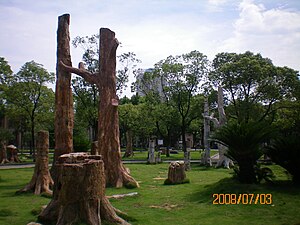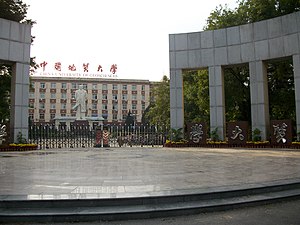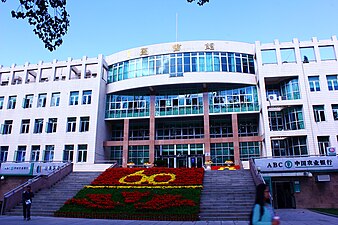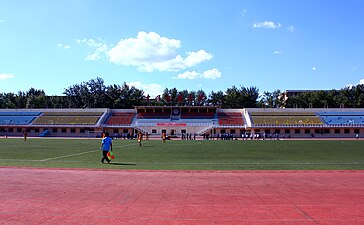China University of Geosciences (Wuhan)
中国地质大学 | |
 | |
| Motto | 艰苦朴素 求真务实 |
|---|---|
Motto in English | Being austere and simple, keeping on practice and acting for truth |
| Type | National Public |
| Established | October 1952 |
| Location | , |
| Campus | Urban |
| Affiliations | Project 211 |
| Website | www.cug.edu.cn (Wuhan) www.cugb.edu.cn (Beijing) |
The China University of Geosciences (simplified Chinese: 中国地质大学; traditional Chinese: 中國地質大學; pinyin: Zhōngguó Dìzhì Dàxué; colloquially 地大; ) is a key national university directly under the administration of the Education Ministry of the People's Republic of China. It consists of two campuses, one is located in Haidian District in Beijing, the second one is located in Wuhan, the capital of Central China's Hubei Province.[1][2]
It is regarded as a top university specialized in geosciences in China and exerts considerable influence within the Chinese mining and oil industry. Its notable alumni include Wen Jiabao, the Premier of China's State Council, who attended the Beijing Campus when it was known as the Beijing Institute of Geology (BIG). The motto "Being austere and simple, keeping on practice and acting for truth." is from him.[1][2]
Campuses
Beijing Campus
The Beijing Campus is located in the original campus of former Beijing Institute of Geology, Xueyuan Road, with a concentration of 8 famous universities and academic tradition.[1] [2]
Wuhan Campus
The Wuhan Campus is located in No. 388 Lumo Road, Wuhan, with a scenic view and a large campus area. It has a larger annual enrollment and provides more available majors other than geosciences.[1] [2] Its Yifu Museum is known for housing China’s top ranked displays of dinosaur fossils, mineral and rock specimens.
History
The history of China University of Geosciences dates back to Beijing Institute of Geology (BIG; simplified Chinese: 北京地质学院; traditional Chinese: 北京地質學院; pinyin: Běijīng Dìzhì Xuéyuàn) which was a merger of the geology departments of Tsinghua University, Peking University, Tianjin University and Tangshan Railway College. It was among China's first 16 key universities back in the 1950s. The university suspended operations from 1966-1970 due to the Cultural Revolution, and reopened in Jiangling County, Hubei Province, in 1970 as Hubei College of Geology (simplified Chinese: 湖北地质学院; traditional Chinese: 湖北地質學院; pinyin: Húběi Dìzhì Xuéyuàn).[3]
In 1975 the campus was moved to Wuhan, and the school was renamed Wuhan College of Geology (WCG; simplified Chinese: 武汉地质学院; traditional Chinese: 武漢地質學院; pinyin: Wǔhàn Dìzhì Xuéyuàn). In 1978 BIG reopened in Beijing with the help of Deng Xiaoping. In 1986 the Chinese Government ratified the foundation of the Graduate School of WCG. It was ranked as one of the first 33 Graduate Schools nationwide. Later in 1987, WCG was renamed "China University of Geosciences" (simplified as "CUG"), and its branch campus in Beijing was renamed the "Graduate School of CUG in Beijing". In 2005, the two campuses in Wuhan and Beijing were renamed China University of Geosciences (Wuhan) and China University of Geosciences (Beijing), respectively. The Ministry of Education still considers the two campuses as a single university. CUG is among the first batch of 15 universities in project 211 for Higher Education.[1][2]
Image gallery
Wuhan Campus
Beijing Campus
Alumni
- Wen Jiabao, Premier of China
- Zhang Wenyue, Governor of Liaoning Province
- Ouyang Ziyuan, Chief Scientist of Chinese Lunar Project
- Gao Ling,a female badminton player
- Wang Fuzhou,a famous Chinese mountain climber
- Li Zhixin,a leading Chinese mountaineer
- Wang Yongfeng,a famous Chinese mountain climber
See also
- Geology of China
- China Geological Survey
- Geological Museum of China
- Wen Jiabao
- Project 211
- Project 985
- C9 League
- China Open Resources for Education
- Education in the People's Republic of China
- OpenCourseWare in China
- Worldwide Universities Network
- List of colleges and universities
- List of schools of Journalism and Communication in China
- National Higher Education Entrance Examination
- Global U8 Consortium
- International Alliance of Research Universities
- Universitas 21
- Workshop on building top-class universities
- Worldwide Universities Network
References
- ^ a b c d e History of China University of Geosciences
- ^ a b c d e A brief Introduction in Chinese Cite error: The named reference "br" was defined multiple times with different content (see the help page).
- ^ Template:En icon History Review of China University of Geosciences
External links
Template:Universities and colleges in Baoding
"People's Republic of China" is an invalid category parameter for Template:Coord missing.
The problem is usually caused either by a spelling mistake or by an-over-precise category.
For a full list of categories, see Category:Unclassified articles missing geocoordinate data and its subcategories.




